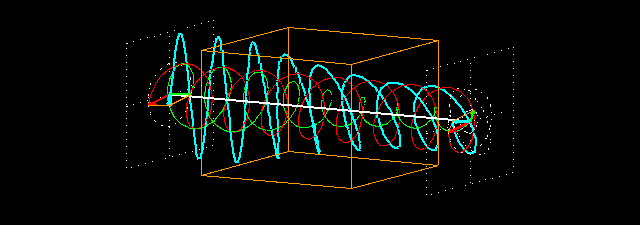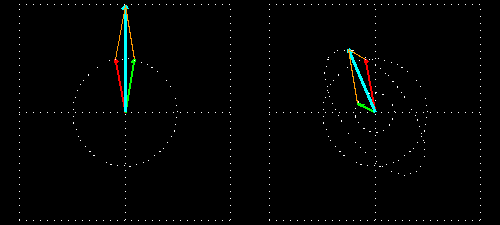
In reality, it rarely occurs that a material exhibits circular dichroism but no circular birefringence or it exhibits circular birefringence but no circular dichroism with respect to light of a certain wavelength.
The following animation shows what happens when a plane-polarized wave (shown in light blue) traverses a medium having both circular dichroism and circular birefringence. Just like on the previous two pages, the two circularly polarized components of the plane-polarized light are shown in red and green color, respectively. The red component traverses the medium unchanged, but the medium has absorption and a refraction index with respect to the green component.

We placed an intersecting plane before and after the piece of material and we show the field vectors at the point of intersection of the light beam and the intersecting planes. The following animation shows the intersecting planes from the front. On the left, the plane before the material; on the right, the plane after the material.

As you could suspect from the phenomena shown on the previous pages, the incident light suffers two modifications here: because of the circular dichroism, it becomes elliptical; and because of the circular birefringence, its polarization gets rotated. Since the exiting light is no longer plane-polarized, it is not the plane of polarization that gets rotated but the big axis of the ellipse of polarization of the elliptically polarized light.
The ellipticity of the light exiting the medium is determined by the difference between the absorptions with respect to the left and right circularly polarized components. The angle made by the big axis of the ellipse with respect to the original polarization plane is determined by the difference between the refraction indices with respect to the left and right circularly polarized components.
With the appropriate instrument, the ellipticity and the angle of rotation of the polarization plane of light can be measured. From those data, the difference between absorptions and refraction indices with respect to left and right circularly polarized lights can be calculated.
Circular dichroism and circular birefringence are caused by the asymmetry of the molecular structure of matter. The optical activity of solutions of biological macromolecules provides information about the structural properties of the macromolecules.